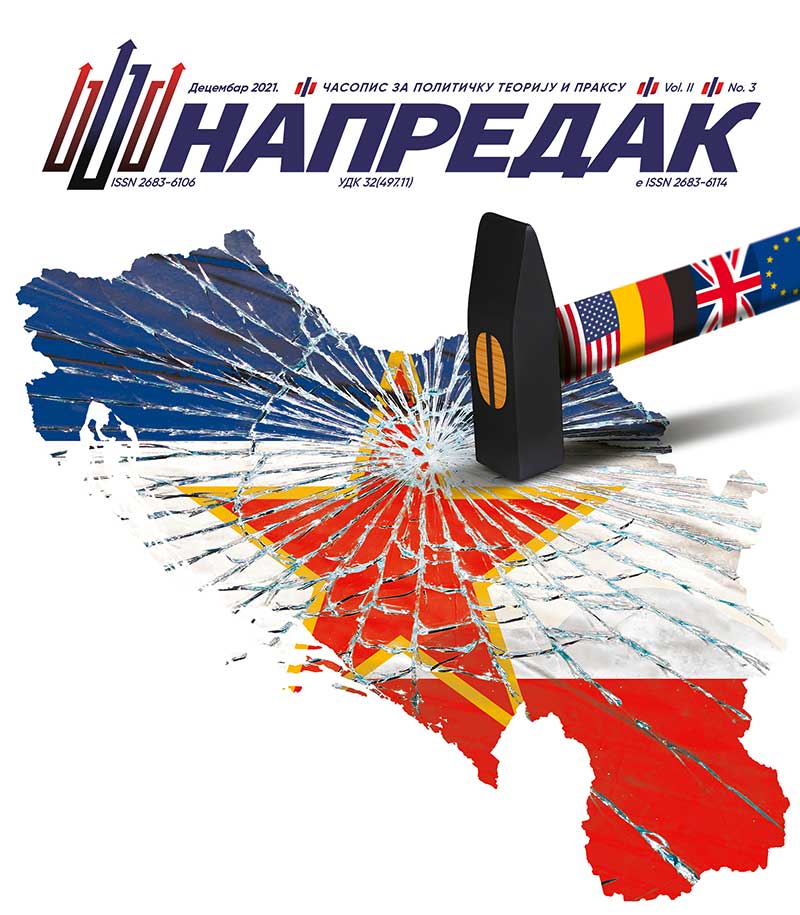Југославија се није распала – она је намерно разбијена
Sažetak
У раду заступамо став да се деведесетих година XX века СФРЈ није распала, него је намерно
разбијена, јер су, према мишљењу САД, нестали разлози за њено постојање. Американци су сматрали да је СФРЈ настала као брана совјетској експанзији према Западу. Будући да више није било биполарног света и да је наступила ера глобализације, престала је потреба за постојањем СФРЈ, те је због тога требало разбити је. Аутори износе мишљење да су СФРЈ разбиле САД, Немачка, Ватикан, друге западне земље и сецесионистичке југословенске републике Словенија и Хрватска. Зато они сносе историјску одговорност за намерно разбијање једне суверене земље, мимо њеног устава, Повеље УН и Хелсиншког споразума.
Reference
Ali, T. (2000). Introduction: After the War. In: T. Ali (ed.), Masters of the Universe: NATO’s Balkan crusade. London; New York: Verso. [In English]
Arsenić, R. (2009, February 12). Tuđman wanted war at any cost. Politika. [In Serbian]
Atlagić, M. (2020). Croatian scientists and politicians falsifying the number of victims in the Jasenovac concentracion camp in the ISC from 1941 to 1945. Napredak, Vol. 1, No. 2, 79-100, Available at: https://fondacijasnd.rs/wp-content/uploads/2020/02/Napredak-br-2_article-5_M-P-Atlagic.pdf . [In Serbian]
Avramov, S. (1997). Postheroic war of the West against Yugoslavia. Belgrade: IGAM. [In Serbian]
Babić, M. Šuvar (2003). Interview with Edin Murtić. Identitet. No. 61. [In Serbian]
Baker, J., DeFrank, T. (1995). The Politics of Diplomacy: Revolution, War and Peace 1989–1992. New York: Putnam. [In English]
Beta (2010, August 24). One of France’s greatest military strategists has died. Politika. [In Serbian]
Bildt, C. (1998). Peace Journey: The Struggle for Peace in Bosnia. London: Weidenfeld and Nicolson. [In English]
Bobetko, J. (1996). All my battles. Zagreb: vlastito izdanje. [In Croatian]
Bogetić, D. (2012). Yugoslav-American relations 1961–1971. Belgrade: Institut za savremenu istoriju. [In Serbian]
Boljkovac, J. (2009, February 13). Croatia caused the war intentionally. Slobodna Dalmacija. [In Croatian]
Bulajić, M. (1992). Mission of the Vatican in the ISC. Belgrade: Politika. [In Serbian]
Cooper, W. (1991). Behold a pale Horse. Arizona: Light Techology Publishing. [In English]
Dabčević-Kučar, S. (1997). Croatian dreams and reality. Zagreb: Interpublic. [In Croatian]
Danas. (1998, аpril 9), no. 477. [In Serbian]
Džonston, D. (2005). Fools’ crusade. Belgrade: Izdavačko grafički atelje „M“. [In Serbian]
Eastern Orthodoxy. (2006, April 15). [In Serbian]
Ekmečić, M. (2002). Essays in history. Belgrade: Službeni list SRJ. [In Serbian]
Feral Tribune. (2001, June 19). [In Croatian]
Feral tribune. (2004, April 30. & August 15). [In Croatian]
Filipović, M. (2015, February 23). Žoze Kutiljero: The war could have been prevented. Večernje novosti. [In Serbian]
Flounders, S. (1998). Bosnia Tragedy, The unknown role of the US government and Pentagon. In: NATO in the Balkans:Voices of opposition. New York: International Action Center. [In English]
Fournemont, J. (1996). Le Vatican et l’ex Yougoslavie. Paris: L’Harmattan [In French]
Gallois, P. (1993, January 28). Balkans: la Faute Allemande. Le quotidien de Paris. [In French]
Gibs, D. (2010). The humanitarian destruction of Yugoslavia. Sremski Karlovci – Novi Sad: Izdavačka knjižarnica Zorana Stojanovića. [In Serbian]
Glas koncila. (1991, August 25). [In Croatian]
Glaurdić, J. (2011). The Hour of Europe: Western Powers and Breakup of Yugoslavia. London: Yale University Press. [In English]
Grajf, G. (2018). Jasenovac: Auschwitz of the Balkans. Belgrade: Knjiga komerc [In Serbian]
Grajf, G. (2019, February 1). At least 800,000 Serbs and 40,000 Jews were killed in Jasenovac. Politika. [In Serbian]
Guskova, J. (2003). History of the Yugoslav Crisis: (1990-2000) . Belgrade: IGAM . [In Serbian]
Kostić, B. (2010, June 18). St Vitus’ Day, warning and admonition. Pečat. [In Serbian]
Kostić, B. (2019, May 25). Preserving the memory of Pierre Galois, a great friend of the Serbian people. Politika. [In Serbian]
Krušelj, Ž. (1991). Dr Franjo Tuđman, at the First General Assembly of the HDZ. Danas. [In Croatian]
Lemkin, R. (1944). Axis Rule in occupied Europe. Washigton DC: Carnegie Endowment for International Peace. [In English]
Merlino, J. (1993). Les vérités yougoslaves ne sont pas toutes bonnes à dire. Paris: Albin Michel [In French]
Mirić, J. (2002). Crime instead of War. Zagreb: Prosveta. [In Serbian]
Newhouse, J. (1992, August 24). The Diplomatic Round: Dodging the Problem. The New Yorker, p.60. [In English]
Perić, I. (1974). The idea of mass movements in Croatia. Zagreb: Narodno sveučilište grada Zagreba. [In Croatian]
Reply, T. (1999). Operation Deliberate Force: The UN and NATO Campaign in Bosnia 1995. Lancaster UK: Centre for Defense and International Security Studies. [In English]
SANU (2006). In: S. Karamata, Č. Ocić (eds) Serbs in Kosovo and Metohija. Belgrade: Srpska akademija nauka i umetnosti. [In Serbian]
Stojanović, S. (2012). Mihailo Marković said. Belgrade: Beogradski forum za svet ravnopravnih. [In Serbian]
Špegelj, M. (2001, June 19). Tuđman was diseased. Feral Tribune. [In Croatian]
Šuvaković, U., Rakić, B. (2017). Genocide and ethnic cleansing or on the disposition of an international crime and a sociological and political science term. Strani pravni život 2/2017, 59–97. [In Serbian]
Šuvar, S. (2004). Croatian carousel. Zagreb: Razlog. [In Croatian]
Tomac, Z. (1993). The Struggle for the Croatian State: Through Hell to Democracy. Zagreb: Prokifon. [In English]
Tripalo, M. (1989). Croatian spring. Zagreb: Globus D.O.O. [In Croatian]
Tuđman, F. (1990, April 17). The protest in Pazin. Danas. [In Croatian]
Tuđman, F. (2004, April 30 & 2006, October 15). After the storm. Feral tribune. [In Croatian]
Tuđman, F.(1998, December 15). President of the Republic of Croatia at the opening of the war school Ban Josip Jelačić in Zagreb. Novi list. [In Croatian]
US Congress. (1999, November 10). Prepared Statement of John Balton, Senior Vice President, American Enterprise Institute, before the House Committee on International relations. Federal News Service. [In English]
Vučić, A. (2020, August 7). Oluja was the largest ethnik cleansing in Europe after WWII. Jutarnji list. [In Croatian]
Woodward, S. (1995). Balkan Tragedy: Chaos and Dissolution after the Cold War. Washington DC: Brookings Institution Press [In English]
Zidić, I. (2017). Croatia and the Croatian spring 1991. Zagreb: Matica Hrvatska. [In Croatian]
Zimmermann, W. (1999). Origins of a catastrophe. Zagreb: Globus – Znanje. [In Croatian]

